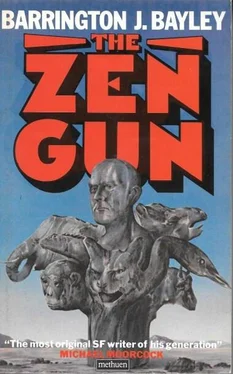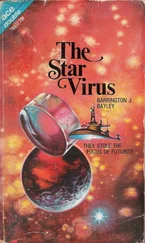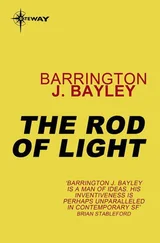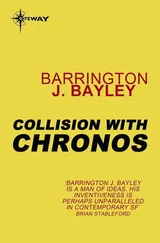“This man is an item of tax,” Arctus trumpeted softly to Archier while the rest of the entourage stared. “A native of Alaxis, to judge by his apparel. That was the planet we levied before we visited Rostia.”
“The ships of the Imperial fleets are reputed to be technically more advanced than those of the subject worlds,” the importuner continued blandly. “Hence my interest. And after all, I shall be formally registered as a first-class citizen once in Diadem. I am one already, of course…”
“Oh, are you an engineer, then?” Archier asked.
The Alaxian smiled. “No, I am a writer of space dramas. Interstellar battles are my stock-in-trade, you might say, and now I have a chance to gain first-hand experience—as well as some background information which could be invaluable.”
Archier, too, smiled. “Perhaps you will compose a suitably embellished account of the action. It should make you famous in Diadem. But actually, you should have asked Captain Prenceuse’s permission, not mine.”
The captain of Lilac Willow shrugged. They moved on, the Alaxian attaching himself to the rear of the group without a further word. As they entered a traverse-elevator and were conveyed through the innards of the great ship, however, he sidled close to Archier.
“Pardon my forwardness, Admiral, but may I introduce myself person to person? I am Volsted Magroom… it is unlikely you have heard of me, but my works are well known on my own world of Alaxis… hence my present situation, of course—though let me say at once,” he added hastily, “how pleased and honoured I am to be deemed worth transporting to Diadem. Flight to Eternity is perhaps my best known composition. It deals with a journey into the Simplex.”
Archier, who had never found time for imaginative literature, looked at the Alaxian with new interest. The theme was intriguing, if hardly original. “The old dream of travel to the Simplex,” he murmured. “How do you manage to convey what it’s like there?”
“The visual effects did cause problems,” Magroom admitted, “but I didn’t have to worry about that too much. I only wrote the script.”
“Your stories mainly take place in the future, I take it? I hope you show the Empire as flourishing and stronger than ever.”
Magroom was apologetic. “I have portrayed a number of alternative futures. They are not meant to be predictive and I have no political views of my own. In some, the Empire has vanished or has been conquered by an alien race to whom our worlds are desirable.”
“That should go down well in Diadem.” If Magroom was thinking of continuing his career there, Archier thought, he could well encounter a more sophisticated audience than he was used to.
Artists imported into Diadem had an uncertain fate; some met with great success because of the novelty of their vision. Others found themselves outmoded.
“Do you think man ever will reach the Simplex, and perhaps other facets?” he asked.
“I have been asked that countless times,” Magroom replied. “Yes, I firmly believe we will, one day. The idea is too fantastic for many, of course—but then the idea of interstellar feetol flight might have seemed fantastic once.”
“ Might it?” Archier gave a puzzled frown. “Well, to stone age people, I suppose.”
Animals, men and women saluted with raised forelimbs as Archier and his party emerged from the travelator into a barrel-shaped hall occupied by a line of similarly barrel-shaped feetol transformers. The casings took up nearly the whole of the hall; it was no more than an outer integument with just enough room for ancillary machinery and staff.
“Is all in order?” Archier asked the engine room manager, a loping mandrill. The ape nodded, briefly showing fangs.
“Tuned to perfection!” he said gruffly. “We worked all the way through our sleep period! Even the robots worked!” He indicated three constructs who cowered in intimidated fashion in one of the hall’s shallow bays.
“My engine manager is a rough and ready fellow and gets things done by direct means,” the captain muttered to Archier with a knowing smile.
“I hope they are not about to complain to their union,” Archier said doubtfully, with a glance at the robots, at which the mandrill uttered a chugging laugh.
“Don’t worry on their account, Admiral. They prefer to stay in one piece!”
Volsted Magroom, meanwhile, was staring up at the dully sheened casings in fascination. The hum that came from them was barely audible; and even this close, their effect on the surrounding spacetime field was not perceptible to the senses.
“Well here they are,” Archier said quietly, stepping close to the fiction writer. “These are what drive the Lilac Willow along. They are not really so very different from commercial engines, just bigger.
“I presume you are familiar with the principle of feetol flight. As is well known, nature generally stipulates that no moving material object may exceed—or even attain—the velocity of light in relation to any other object. This, however, is a consequence of the structure of space. Put technically, it is a feature derived from the recession lines which make up spacetime. A feetol generator alters the characteristics of spacetime in its vicinity by attenuating the recession lines. This causes the velocity of light itself to be raised within the feetol bubble. The ship carrying the generator may then accelerate itself up to the new limit, whatever that may be.
“Popular writers sometimes describe the feetol drive as ‘breaking the laws of physics’; of course, this is not so. It remains impossible to travel faster than light in the spacetime vicinity one occupies. The limiting velocity, formerly a constant is turned into a variable, that is all.
“Many commercial ships carry a double drive: a feetol generator to attenuate local space and a separate drive unit to propel the ship through it. Larger generators, such as those you see before you, allow a further refinement and can serve both functions, both space modifier and propulsion unit. They do this by ‘seizing hold,’ so to speak, of the recession lines they attenuate. The ship is then able to move in reaction against the general electromagnetic field of the galaxy—a piece of ingenuity which considerably reduces the working machinery that is needed.
“Under its own generators alone the Lilac Willow can move at some hundreds of times the normal velocity of light. The fleet as a whole, however, is actually able to shift considerably faster than that, travelling in formation. Feetol bubbles can merge, and the larger the bubble the more attenuated the spacetime within it becomes. Only the fleets of Star Force are permitted this facility; it is why they are able to move around the Empire so fast.”
“So that’s why the interstellar service lines are practically forbidden to own more than one or two ships?”
Archier nodded. “We don’t want private operators to gain experience in meshing feetol drives.”
He felt pride as he stood by the Alaxian, drinking in the sight of the big armature-like casings. Delivering his exposition to the writer made him feel as though he were back at training academy; in fact he had largely been quoting from one of the preliminary lectures he had heard there.
“The other facility that comes from the composite bubble method is something few who have never travelled in a Star Force fleet are even aware of,” he continued. “That is the intermat system. You have probably seen it in action by now. It becomes possible when space is attenuated to a certain degree.”
“There are always rumours the Empire has developed the instantaneous transmission of matter,” Magroom said. “Frankly I hadn’t believed it until now.”
Читать дальше












